QSDA2019 Online Practice Questions and Answers
A company generates 1 GB of ticketing data daily. The data is stored in multiple tables Business users need to see trends of tickets processed for the past two years. Users very rarely access the transaction-level data for a specific date. Only the past two years of data must be loaded which is 720 GB of data Which method should a data architect use to meet these requirements?
A. Load only two years of data in an aggregated app and create a separate transaction app for occasional use
B. Load only two years of data and use best practices in scripting and visualization to calculate and display aggregated data
C. Load only aggregated data for two years and use Direct Discovery for transaction data
D. Load only aggregated data for two years and use ODAG for transaction data
A data architect needs to load Table_A from an Excel file and sort the data by Field_2. Which script should the data architect use?
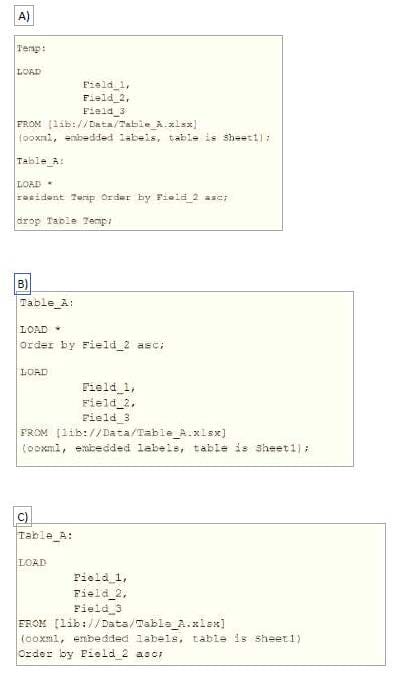
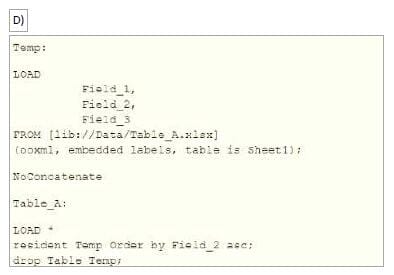
A. Option A
B. Option B
C. Option C
D. Option D
A data architect needs to write the expression for a measure on a KPI to show the sales person with the
highest sales. The sort order of the values of the fields is unknown. When two or more sales people have
sold the same amount, the expression should return all of those sales people.
Which expression should the data architect use?
A. Concat(DISTINCT IF{Aggr{Rank{Sum(Sales),4),Salesperson)=1,Salesperson),' ')
B. FirstSortedValue{DISTINCT Salesperson,-Aggr{Sum(Sales),Salesperson))
C. Concat(DISTINCT IF{Aggr{Rank{Sum(Sales),1),Salesperson)=1, Salesperson) , ' ')
D. FirstSortedValue {Salesperson, -Aggr (Sum{Sales), Salesperson))
Refer to the exhibit.

A data architect is loading the tables and a synthetic key is generated. How should the data architect resolve the synthetic key?
A. Create a composite key using OrderlD and LineNo
B. Remove the LineNo field from Shipments and use the AutoNumber function on the OrderlD field
C. Remove the LineNo field from both tables and use the AutoNumber function on the OrderlD field
D. Create a composite key using OrderlD and LineNo, and remove OrderlD and LineNo from Shipments
A company decides to migrate all apps from QlikView to Qlik Sense. After converting an apps: there are several unconverted objects.
What should the data architect do?
A. Save the unconverted objects as extensions and import them into Qlik Sense
B. Remove the set analysis statements from the unconverted objects
C. Re-create the unconverted objects
D. Save the unconverted objects as master items
A data architect builds a data model for a large user group. Some sheets will be published, and the app will
allow users to create their own visualizations and analyze data. Some fields must NOT appear in any field
list.
How should a data architect meet these requirements?
A. Use HidePrefix variable
B. Add fields to master items
C. Use security rules
D. Use HideField variable
Refer to the exhibit.
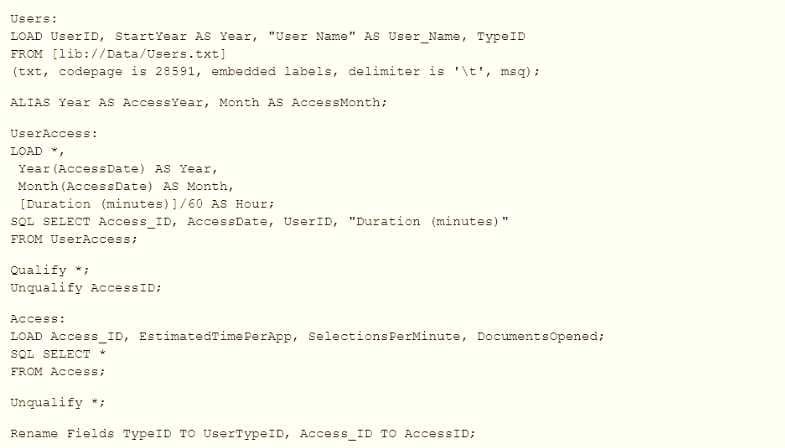
A. The UserAccess table contains seven fields Year Month, Hourr AccesslD. AccessDate. UserlD, and Duration (minutes) The table is only linked to Users on the UserlD field
B. The UserAccess Table contains seven fields: Year, Month. Hour. AccessID, AccessDate. UserlD, and Duration (minutes) The table is linked to the Access table with the AccessID field and linked to Users on the UserlD field
C. The UserAccess table contains seven fields AccessYear, AccessMonth, Hour AccesslD, AccessDate, UserlD, and Duration (minutes) The table is only linked to Users on the UserlD field
D. The UserAccess table contains seven fields AccessYear. AccessMonth. Hour. AccesslD, AccessDate. UserlD. and Duration (minutes) The table is linked to the Access table on the AccesslD field and linked to Users on the UserlD field
Refer to the exhibit.

A shipping company needs to track its shipments using Qlik Sense A data architect has the data in Excel as shown on the left Business rules state that if the ShipmentDate field is empty, it should be populated with the first valid previous date as shown on the right.
Which script should the data architect use to meet this requirement?
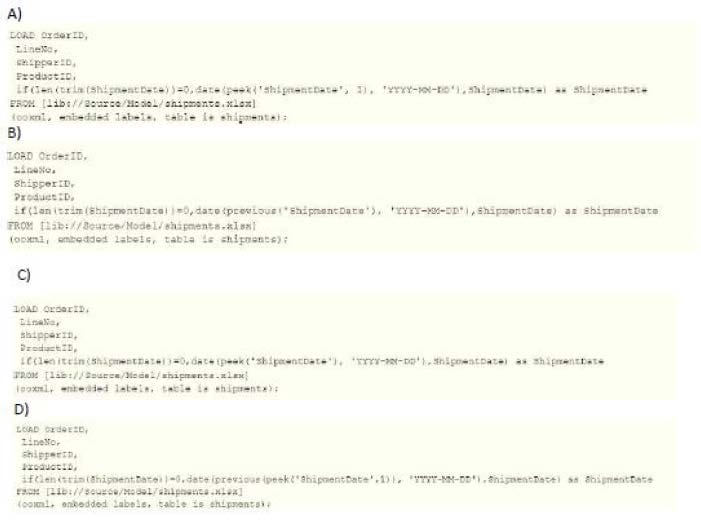
A. Option A
B. Option B
C. Option C
D. Option D
Refer to the exhibit.
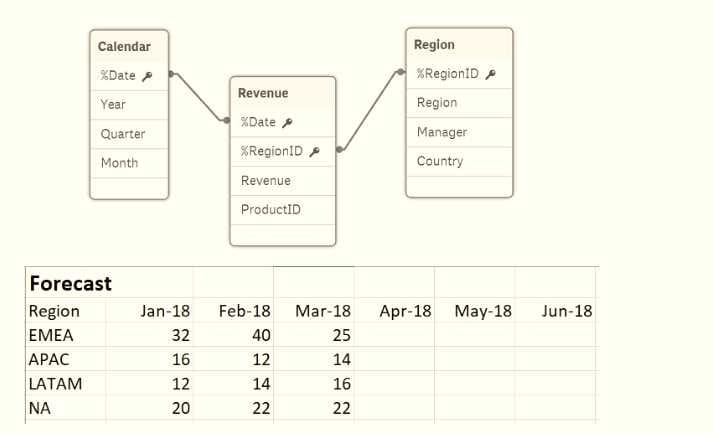
A business department is forecasting revenue within an Excel spreadsheet. A data architect needs to
include this forecast into the existing data model, and without losing any data.
Which two sets of steps will meet these requirements? (Select two.)
A. 1. Load the Excel spreadsheet using the data load editor
2.
Use the Unpivot function
3.
Use the Sum function to group the forecast by date
4.
Connect to the existing data model
B. 1. Load the Excel spreadsheet using the data load editor
2. Use the Crosstable function to unpivot the table
3 Create a composite key out of the date and region
4 Connect the new table to the data model
C. 1. Load the Excel spreadsheet using the data load editor
2.
Change the sort order by date
3.
Create a composite key out of the forecast and region
4.
Connect to the existing data model
D. 1. Load the Excel spreadsheet into the data manager
2.
Use the Unpivot function
3.
Create a composite key from the date and region
4.
Connect the new table to the data model
E. 1. Load the Excel spreadsheet using the data manager
2.
Rename the ForecastDate field to Date
3.
Disable the Region
4.
Connect to the existing data model
Refer to the exhibit.
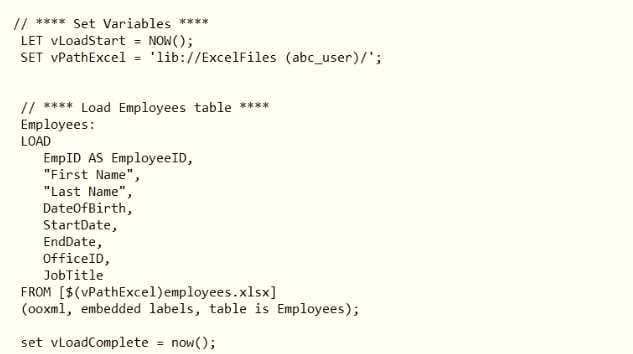
What are the values of the variables vLoadStart and vLoadComplete after the script executes?
A. vLoadStart; 'NOW{)' vLoadComplete: current system date and time when the script ended
B. vLoadStart: system date when the app was opened vLoadComplete 'now()'
C. vLoadStart: system date when the app was opened vLoadComplete: current system date and time when the script ended
D. vLoadStart: current system date and time when the script started vLoadComplete: 'now()'